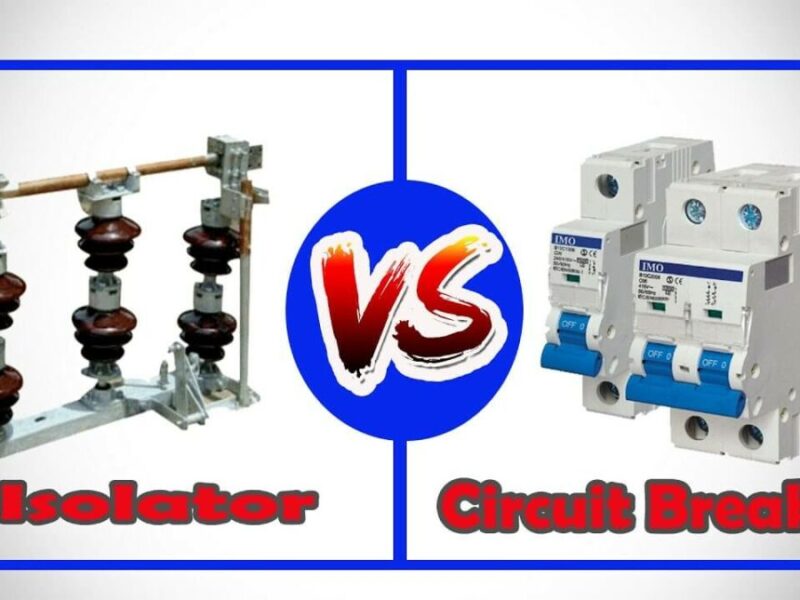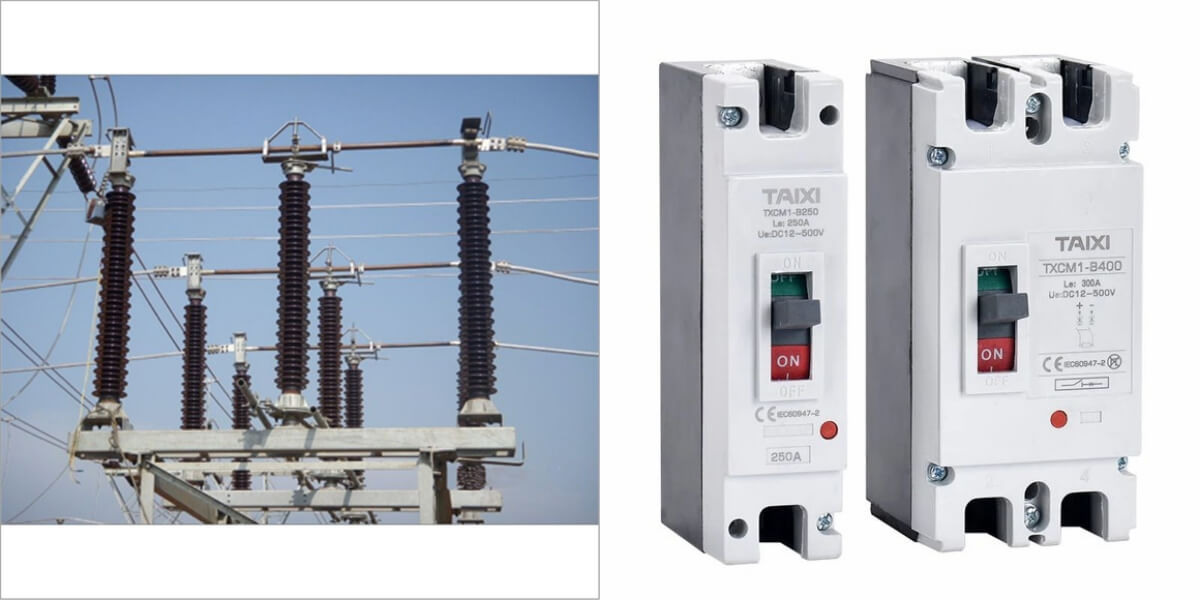
Isolator vs. Circuit Breaker: Key Differences and Functions in Electrical Systems
isolators vs. circuit breaker Ensuring the safe and reliable operation of electrical systems requires effective protection against load currents and fault conditions. Two crucial components that serve this purpose are isolators and circuit breakers, especially in medium-voltage switchgear assemblies. While both are designed to disconnect electrical circuits, they serve distinct functions and operate under different conditions.
This article provides a detailed comparison of isolators vs. circuit breakers, including miniature circuit breakers (MCBs) and residual current circuit breakers (RCCBs), to help you understand their roles, applications, and key differences.
1. What Are Isolators and Disconnectors?
Isolators, also referred to as disconnect switches, are mechanical devices used to physically separate a portion of the circuit from the power supply. Their key characteristic is that they must be operated only under no-load conditions, meaning zero current flow must be ensured before operation.
Applications of Isolators:
- Used during maintenance, inspections, or equipment repair.
- Help prevent accidental energization of the system.
- Ensure safety for technicians by eliminating the risk of electric shock.
Isolators do not contain arc extinguishing systems. Attempting to operate them under load can result in dangerous arcs or equipment damage. Therefore, isolators serve as manual safety devices, not for interrupting load or fault currents.
2. What Is a Circuit Breaker?
A circuit breaker is an automatic switching device designed to interrupt current flow in the event of an overload, fault, or short circuit. It acts as a safety mechanism that detects faults and disconnects the power supply quickly to prevent system damage or fire hazards.
Key Features of Circuit Breakers:
- Can operate automatically or manually.
- Equipped with arc extinguishing systems (air, SF₆, or vacuum).
- Used for load interruption, fault protection, and system regulation.
- Suitable for both industrial and residential environments.
Circuit breakers are essential in protecting high-load equipment like transformers, ensuring system integrity even during high fault current conditions.
3. Isolator vs. Circuit Breaker: 21 Key Differences
| Aspect | Isolator | Circuit Breaker |
|---|---|---|
| Function | Used for isolating part of the system for maintenance | Interrupts load and fault currents automatically |
| Construction | Simple mechanical device | Electromechanical device with arc-quenching system |
| Installation | Typically installed on both sides of a circuit breaker | Installed within live circuits |
| Application | Industrial use only | Used in industrial and domestic settings |
| Interrupting Capacity | Cannot break load current | Can break load and fault currents |
| Current Withstand | Low withstand capacity | High withstand capacity |
| Device Type | Off-load device | On-load device |
| Operating Conditions | Must be operated when power is off | Can operate under load or fault |
| Operation | Manual only | Manual and automatic |
| Arc Medium | Air | Air, vacuum, SF₆, or oil |
| Visibility | Physical contacts visible for maintenance | Internal components not visible |
| Safety | High safety for technicians | Requires skilled operation |
| Insulation Requirement | No insulation needed | Insulation is required |
| Charge Removal | Can remove trapped charges | Cannot remove trapped charges |
| Interruption Time | Only during maintenance | During fault or overload conditions |
| Poles | More poles available | Fewer poles typically used |
| Maintenance | Regular and frequent | Less frequent, professional maintenance required |
| Symbol | Includes horizontal line in diagram | No horizontal line in symbol |
| Current Operation | Operates only when current is zero | Operates regardless of load |
| Grounding | Can include grounding switches | Cannot include grounding switches |
| Cost | Lower cost | Higher cost |

4. MCB vs. RCCB: Understanding the Differences
Miniature Circuit Breakers (MCBs) and Residual Current Circuit Breakers (RCCBs) are two common types of circuit protection devices, but they serve distinct purposes:
| Aspect | MCB | RCCB |
|---|---|---|
| Main Function | Protects against overcurrent and short circuits | Protects against earth faults and electric shock |
| Sensitivity | Less sensitive | More sensitive to leakage currents |
| Application | Industrial, residential, commercial | Mainly residential and personal safety applications |
| Poles | Single, double, triple, four poles | Same as MCBs, but not single pole only |
| Protection Type | Equipment protection | Personal protection |
5. Conclusion
Both isolators and circuit breakers play a vital role in electrical system safety and performance. While they might appear to serve similar purposes, their operational principles, construction, and applications are significantly different.
- Isolators are designed for safe manual disconnection under no-load conditions and are primarily used for maintenance and safety.
- Circuit breakers are advanced protective devices capable of automatically detecting and interrupting fault currents to safeguard the system.
A clear understanding of their functions helps ensure proper selection and usage in medium-voltage switchgear and other electrical systems. For reliable and efficient power system design, consult professionals or trusted manufacturers to select the right components for your needs.
Professiona Switchgear supplier and manufacturer
- Zhejiang GONGSHUN Electrical Co.,Ltd (electricgs.com), Our company was founded in the late 1990s, specializing in the production of inflatable cabinets, SF6 inflatable cabinets, and various high and low voltage complete sets of electrical equipment. It has multiple subsidiaries under its jurisdiction, including high-voltage load switch branch, high-voltage circuit breaker branch, high-voltage fuse branch, and technology development branch.Our technical expertise, comprehensive product portfolio and long-term rich experience are helping many customers in need to solve their power problems. We’re happy to help at any time. Whether you need application product advice or technical assistance, our global service team is committed to providing you with the right support. For more technical information about medium voltage earthing switch, feel free to contact us, send an email to gongshun@electric-cn.com
- Our company specializes in producing 12KV-40.5KV series high-voltage electrical products: FZN58, FLN48, FLN36, FZRN25, FZN21, FN18, ZFN16, FN12, FN8, FN7, FN5, XRNT, XRNP, VS1, ZN28, ZW8, ZW32, JN15, GN19, GN22, GN24, GN30, CLXGN15-12, HXGN □ -12, DXG-12 (L), DFW □ -12 high-voltage cable branch box, CLXGN □ -12 (SF6) series inflatable cabinet 12KV and 35KV cable accessories, etc; CLVXP-12 indoor AC high voltage fixed switchgear, CL-SIS-12 compact solid insulated ring main unit, professional assembly Schneider SC6 (SF6) series load switchgear, ABB produced SFG (SF6) series load switchgear and other series products; Distribution and agency of high-voltage load switches and inflatable cabinets produced by Schneider Electric and ABB; Siemens produces the 3AJ1 series of indoor medium voltage vacuum circuit breakers and other related products. The company has a complete range of products and has been operating safely on domestic and international power grids for a long time, receiving unanimous praise from both new and old users. Among them, multiple products such as FZRN25, FN12, FLN36-12, XRNT-12 have been exported to various countries and regions in East Asia, South Asia, Southeast Asia, Africa, and the United States.
